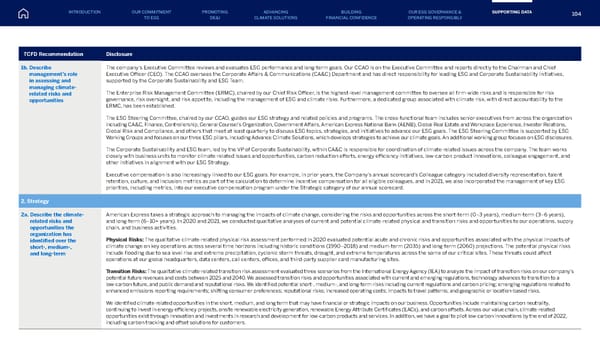TCFD Recommendation Disclosure 1b. Describe management’s role in assessing and managing climate- related risks and opportunities The company’s Executive Committee reviews and evaluates ESG performance and long-term goals. Our CCAO is on the Executive Committee and reports directly to the Chairman and Chief Executive Officer (CEO). The CCAO oversees the Corporate Affairs & Communications (CA&C) Department and has direct responsibility for leading ESG and Corporate Sustainability initiatives, supported by the Corporate Sustainability and ESG Team. The Enterprise Risk Management Committee (ERMC), chaired by our Chief Risk Officer, is the highest-level management committee to oversee all firm-wide risks and is responsible for risk governance, risk oversight, and risk appetite, including the management of ESG and climate risks. Furthermore, a dedicated group associated with climate risk, with direct accountability to the ERMC, has been established. The ESG Steering Committee, chaired by our CCAO, guides our ESG strategy and related policies and programs. The cross-functional team includes senior executives from across the organization including CA&C, Finance, Controllership, General Counsel’s Organization, Government Affairs, American Express National Bank (AENB), Global Real Estate and Workplace Experience, Investor Relations, Global Risk and Compliance, and others that meet at least quarterly to discuss ESG topics, strategies, and initiatives to advance our ESG goals. The ESG Steering Committee is supported by ESG Working Groups and focuses on our three ESG pillars, including Advance Climate Solutions, which develops strategies to achieve our climate goals. An additional working group focuses on ESG disclosures. The Corporate Sustainability and ESG team, led by the VP of Corporate Sustainability, within CA&C is responsible for coordination of climate-related issues across the company. The team works closely with business units to monitor climate-related issues and opportunities, carbon reduction efforts, energy efficiency initiatives, low-carbon product innovations, colleague engagement, and other initiatives in alignment with our ESG Strategy. Executive compensation is also increasingly linked to our ESG goals. For example, in prior years, the Company’s annual scorecard’s Colleague category included diversity representation, talent retention, culture, and inclusion metrics as part of the calculation to determine incentive compensation for all eligible colleagues, and in 2021, we also incorporated the management of key ESG priorities, including metrics, into our executive compensation program under the Strategic category of our annual scorecard. 2. Strategy 2a. Describe the climate- related risks and opportunities the organization has identified over the short-, medium-, and long-term American Express takes a strategic approach to managing the impacts of climate change, considering the risks and opportunities across the short-term (0–3 years), medium-term (3–6 years), and long-term (6–10+ years). In 2020 and 2021, we conducted qualitative analyses of current and potential climate-related physical and transition risks and opportunities to our operations, supply chain, and business activities. Physical Risks: The qualitative climate-related physical risk assessment performed in 2020 evaluated potential acute and chronic risks and opportunities associated with the physical impacts of climate change on key operations across several time horizons including historic conditions (1990–2018) and medium-term (2035) and long-term (2060) projections. The potential physical risks include flooding due to sea level rise and extreme precipitation, cyclonic storm threats, drought, and extreme temperatures across the some of our critical sites. These threats could affect operations at our global headquarters, data centers, call centers, offices, and third-party supplier card manufacturing sites. Transition Risks: The qualitative climate-related transition risk assessment evaluated three scenarios from the International Energy Agency (IEA) to analyze the impact of transition risks on our company’s potential future revenues and costs between 2025 and 2040. We assessed transition risks and opportunities associated with current and emerging regulations, technology advances to transition to a low-carbon future, and public demand and reputational risks. We identified potential short-, medium-, and long-term risks including current regulations and carbon pricing; emerging regulations related to enhanced emissions reporting requirements; shifting consumer preferences; reputational risks; increased operating costs; impacts to travel patterns; and geographic or location-based risks. We identified climate-related opportunities in the short, medium, and long term that may have financial or strategic impacts on our business. Opportunities include maintaining carbon neutrality, continuing to invest in energy efficiency projects, onsite renewable electricity generation, renewable Energy Attribute Certificates (EACs), and carbon offsets. Across our value chain, climate-related opportunities exist through innovation and investments in research and development for low-carbon products and services. In addition, we have a goal to pilot low-carbon innovations by the end of 2022, including carbon tracking and offset solutions for customers. INTRODUCTION PROMOTING DE&I ADVANCING CLIMATE SOLUTIONS BUILDING FINANCIAL CONFIDENCE OUR ESG GOVERNANCE & OPERATING RESPONSIBLY SUPPORTING DATA OUR COMMITMENT TO ESG 104
 American Express ESG Report Page 103 Page 105
American Express ESG Report Page 103 Page 105